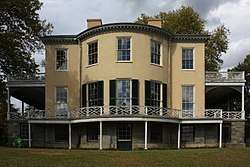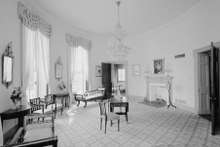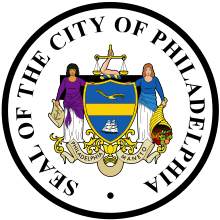Lemon Hill
| Lemon Hill | |
|---|---|
 Rear elevation with oval wall | |
| Location | Philadelphia, Pennsylvania |
| Coordinates | 39°58′15″N 75°11′14″W / 39.97083°N 75.18722°WCoordinates: 39°58′15″N 75°11′14″W / 39.97083°N 75.18722°W |
| Built | c.1800[1] |
| Architect | Henry Pratt[2] |
| Architectural style(s) | Federal[1] |
| Owner | Henry Pratt[2] |
| Official name: Fairmount Park, Lemon Hill | |
| Designated | February 7, 1972 |
| Reference no. | 72001151[3][4] |
 Location of Lemon Hill in Philadelphia  Lemon Hill (Pennsylvania)  Lemon Hill (the US) | |
Lemon Hill is a Federal-style mansion in Fairmount Park, Philadelphia, built around 1800 on land owned by Henry Pratt. Pratt was a merchant who owned a fleet of ships and speculated in real estate. The mansion is situated on a parcel of land that had been part of Robert Morris's 300-acre (120 ha) estate called The Hills. Pratt purchased 43 acres (17 ha) of The Hills at a sheriff's sale for $14,654 in 1799 after Morris had financial misfortunes and was taken to debtors' prison.[1] The house was designed, and construction was supervised, by Pratt[2] who named his mansion after the many lemon trees in Morris's greenhouse. The adjacent gardens and greenhouse were included in the purchase and Pratt opened them to the public for an entry fee. Pratt did not stay year-round at Lemon Hill, as he lived mainly in his Old City townhouse on Front Street. Lemon Hill was used as his summer retreat from the city; a place which he used for business entertaining and general socializing.[1]
The house was added to the National Register of Historic Places on February 7, 1972 as an inventoried contributing structure within Fairmount Park.[3][4]

Lemon Hill is located on a bluff overlooking the Schuylkill River and Boathouse Row. Exceptional architectural features include its three oval parlors, stacked one on top of the other, with curved fireplace mantles and doors.
To protect its water supply, the City of Philadelphia began purchasing properties along the Schuylkill River, beginning with Lemon Hill in 1844.[1] The Lemon Hill area formed the basis for what is now Fairmount Park.
The mansion was restored by the architectural historian Fiske Kimball who lived there from 1926–55 while director of the Philadelphia Museum of Art. He conjectured that Robert Morris had built the mansion; however, in 2005, Pratt's letterbooks were found at the William L. Clements Library of the University of Michigan, Ann Arbor by an assistant curator of the Art Museum. Tax records indicated that the mansion did not exist at the time Pratt had purchased the land. The records also revealed that Pratt was both the designer and general contractor for his mansion.[2]
Owned by the City of Philadelphia, it is operated as a house museum by the Colonial Dames of America and the Friends of Lemon Hill. Long hidden by dense trees on the sides of the hill, a restoration of the historic views was undertaken in 2007, recreating the original vistas of, and from, the mansion.[5]
See also
![]()
External links
![]()
References
- Moss, Roger W., and Tom Crane. Historic Houses of Philadelphia: A Tour of the Region's Museum Homes. Philadelphia: University of Pennsylvania Press, 1998.
- Richard Webster, Philadelphia Preserved (Philadelphia: Temple University Press, 1976).
- 1 2 3 4 5 "200 Years of Splendor in Fairmount Park" (archive). lemonhill.org. Colonial Dames of America and the Friends of Lemon Hill. June 14, 2005. Retrieved November 7, 2017.
- 1 2 3 4 "Henry Pratt's Account for Lemon Hill". by Martha Halpern. antiquesandfineart.com. Antiques and Fine Art Magazine. June 2005. Retrieved November 7, 2017.
- 1 2 National Park Service (November 2, 2013). "National Register Information System – Fairmount Park (#72001151)". National Register of Historic Places. National Park Service. Retrieved November 2, 2017.
- 1 2 "National Register of Historic Places Inventory - Nomination Form". (archive) by George B. Tatum of the Philadelphia Historical Commission. dot7.state.pa.us. National Park Service document via the Commonwealth of Pennsylvania's Cultural Resources Geographic Information System, the Department of Transportation website and the records of the Pennsylvania Historical and Museum Commission. January 11, 1972. Retrieved November 7, 2017.
- ↑ Lemon Hill viewscape restoration (archive)
